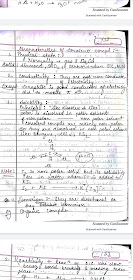1)Charge of cations and anions.(More charge=Stronger electrostatic field, more energy released)
2)Ease of formation of cations and anions:-This includes ionisation enthalpy,bond dissociation enthalpy ..etc…
3)Cation/anion size ratio:- One of the biggest factors as it affects lattice energy which is a major contributor to stability.
4)Lattice point arrangements:- The arrangements of cations and anions in most favourable lattice structure leads to highest stability.
Eg:- NaCl is extensively stable(Its very very high melting and boiling points)
Because of:-
1)Na+ and Cl- ions have electrostatic attraction. Due to very close interaction, they have good ionic bonding (Attraction).
2)Atomisation of and melting point of Na is low along with ionisation energy. Similarly Cl2=>2Cl(Bond dissociation is also low) but Cl has highest electron affinity. Hence it is quite feasible
3)Na+/Cl- is just the right size to give best possible symmetric structure (Rock Salt structure) leading to very high lattice energy.
Or shortly
- Electron gain anthalpy
2. Ionisation anthalpy
3. Sublimation anthalpy
4. Lattice energy of formation
(Overall bohr habber cycle)
Q.which has the most ionic character, the answer is whichever pair exhibits the most difference in electronegativity between the two atoms.
On the Pauling Scale, for the most common oxidation state, Li = 0.98, Na = 0.93, K = 0.82, Cs = 0.79, Mg = 1.31, and I = 2.66.
Ionic character of any molecule depends on the size of cation, anion and on the charges of cation and anion.
In the given example we are provided with same anion so the size and charge of the anion is same in all the cases i.e. Cl^-.
Now consider the cations they all are alkaline earth metals having +2 charge so here also charge is same in every case.
So the only thing which we need to consider is the size of cation. As we know as we move down the group size of atoms goes on increasing. So here the increasing order of size is:
Be, Mg, Ca, Ba
Now according to Fajan's rule
Larger the size of cation and smaller the size of anion favours ionic character in molecules.
Now in the given example we know that Be is smallest in size while Ba is largest one. So the increasing order of ionic character is:
BeCl2, MgCl2, CaCl2, BaCl2.
cations,the size of the cations increase as follows:
Be<Mg<Ca<Sr<Ba
According to Fajan's rules, a molecule with “large cation and a small anion” exhibits Ionic character.Some other factors for a molecule to exhibit Ionic character are:
- Small charge on ions.
Eg:- Ionic character : NaCl (+1;-1) <MgCl2(+2:-2)
- Cations with inert gas configuration.
Eg:- Ionic character : Na+ : 1s2 2s2 2p6 (2,8) > Cu+ : 1s2 2s2 2p6 3s2 3p6 3d10 (2,8,18). { In NaCl and Cu2Cl2}.
So, in the given set, the order of increasing ionic character is as follows:
BeCl2<MgCl2<CaCl2<BaCl2 .

















No comments:
Post a Comment